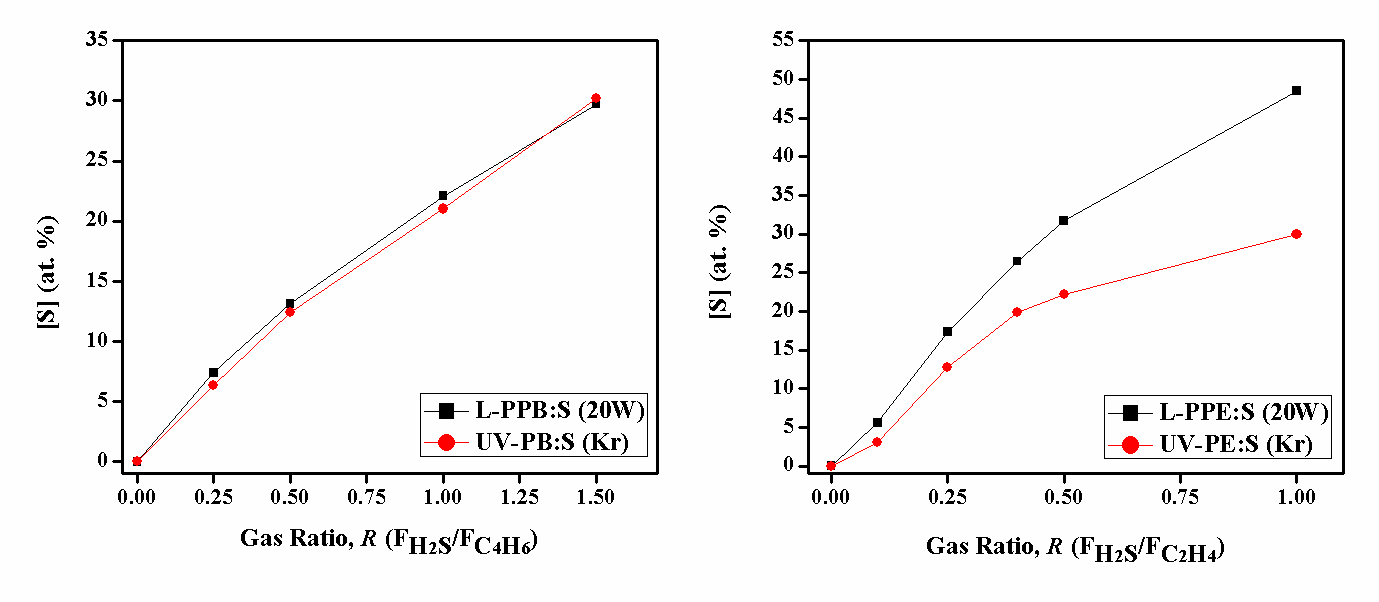Introduction: The performance of synthetic polymers, including applications in biomedical fields, can be improved by modifying their surface properties. Polymer surfaces generally have low chemical reactivity,are not capable of forming adhesive bonds, and poorly-wetting. Among different modified surfaces, thiol (SH)-terminated ones have been progressively gaining interest over the past years[1]. They have been shown useful for many applications, such as promoting adhesion of gold layers and nanoparticles, and for immobilizing biomolecules. An important advantage of using SH-terminated surfaces for biomolecule immobilization is the possible covalent attachment of these molecules via thiol-ene click chemistry, superior to electrostatic attachment[2].
Materials and Methods: In this work, thin organic films incorporating sulfur (S)-bearing functional groups have been prepared by “co-polymerizing” gas mixtures of ethylene (C2H4) or butadiene (C4H6), as hydrocarbon source, with H2S, as source of bound S in the coatings. This has been accomplished by either (i) vacuum-ultraviolet (VUV) irradiation of the reagent gas mixtures at reduced pressure with near-monochromatic radiation from a Kr lamp (λ = 123.6 nm); or (ii) by low-pressure r.f. plasma-assisted chemical vapor deposition (PACVD).
The different films were prepared with gas mixture ratios, R (e.g. FH2S/FC4H6), ranging from 0 to 1.5. The polymer-like coatings resulting from photo-chemical or plasma reactions are respectively designated ‘‘UV-PB/E:S’’ (for ‘‘ultraviolet- polymerized sulfurized butadiene/ethylene’’), or L-PPB/E:S (for ‘‘low-pressure plasma-polymerized, sulfurized butadiene/ethylene’’).
All deposits were characterized by X-ray photoelectron spectroscopy (XPS) before and after chemical derivatization with N-ethylmaleimide, which serves to quantify the thiol concentrations, [SH], on the surfaces. The stability of the coatings was measured as loss of thickness in water after 24h of immersion.
Results and Discussion: XPS survey spectra of the deposited films at different R values reveal important amounts of bonded sulfur, the concentration, [S], being found to increase with rising R, namely 2 ≤ [S] ≤ 48 at. % (Figure 1). This analysis also shows that both deposition methods, plasma and VUV, influence [S] in quite similar ways. After derivatization with N-ethylmaleimide, some differences between the two film types can be observed: plasma-polymers show higher [SH] values, up to 3 %. After immersing the films in toluene for 24h, no significant differences in [S] were observed, indicating that the remaining S content in the films is not inorganic, but otherwise- bonded organic sulfur. The stability in aqueous media of all investigated coatings is a key requirement when used in biomedical applications: after immersion in water for 24h, all remained of essentially unchanged thickness.

Figure 1 Surface-near sulfur concentrations, [S] (in at.- %), of a) L-PPB:S (squares, 20 W) and UV-PB:S (circles, KrL); b) L-PPE:S (squares, 20 W) and UV-PE:S (circles, KrL), both as a function of gas mixture ratio, R.
Conclusion: To our knowledge, we are for the first time, demonstrating thiol-terminated surfaces by “co-polymerizing” mixtures of a hydrocarbon and H2S, by both vacuum-ultraviolet photo-CVD and low-pressure r.f. PACVD. All of the obtained deposits show significant [S] values, whereof a satisfactory portion is bonded in the form of thiols. These SH-terminated surfaces show good stability in aqueous media, a characteristic that is essential for biomedical applications.
The authors would like to acknowledge McGill Engineering Doctoral Award (MEDA), Fonds de recherche du Québec (FQRNT) and Natural Sciences and Engineering Research Council of Canada (NSERC) for the funding
References:
[1] Thiry, D.; Francq, R.; Cossement, D.; Guillaume, M.; Cornil, J.; Snyders, R. Plasma Process. Polym. 2014, 11, 606.
[2] Weinrich, D.; Lin, P. C.; Jonkheijm, P.; Nguyen, U. T.; Schroder, H.; Niemeyer, C. M.; Alexandrov, K.; Goody, R.; Waldmann, H. Angew Chem Int Ed Engl 2010, 49, 1252.